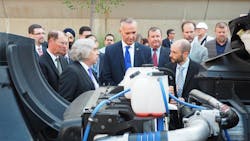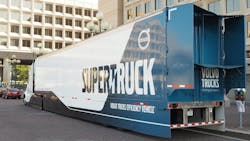WASHINGTON. At Volvo's unveiling Tuesday of the truck it produced under the Dept. of Energy's (DOE) SuperTruck project, the company said the effort had been illuminating, helping its engineers design a vehicle not by improving this or that element but as a whole.
"We looked at it as a knowledge accelerator," said Göran Nyberg, president of Volvo Trucks North America. "It's a milestone in our history."
Part of DOE's objective with this project — and for the next iteration of it announced earlier this year — is feasibility, the idea being to produce technologies and innovations that'll actually make it into trucks on North American roads. Volvo took an accordingly measured approach to its SuperTruck, Nyberg explained, considering practicality for commercial production of the different technologies employed.
U.S. Sec. of Energy Ernest Moniz toured the Volvo SuperTruck outside the department's headquarters and expanded on that point. "I think a big part of it is going to be to keep working on the engineering to get the costs down so that these efficient trucks become the standard in the United States and frankly, in the global market," he said, noting ongoing efforts under SuperTruck II.
SuperTruck I goals
The target for SuperTruck project participants was to deliver a truck capable of 50% greater freight efficiency than a 2009 truck baseline, and Volvo's SuperTruck overshot the goal with 88% higher freight efficiency. It's a pretty straight calculation: freight efficiency is freight tonnage multiplied by miles per gallon the vehicle gets. Per project rules, Volvo's SuperTruck efficiency was calculated with the truck loaded to 65,000 lbs. and doing a constant 64 mph.
Here are some more stats: Volvo's SuperTruck boasts more than a 70% improvement in fuel economy compared with that 2009 baseline, achieving better than 12 mpg; Nyberg said that in recent testing, the truck is hitting 13 mpg. And thanks to aerodynamic improvements on the SuperTruck, Volvo's 2016 VNL series trucks benefitted from improved bumper, chassis and roof aerodynamics good for up to a 3.5% increase in fuel economy.
In addition, as Volvo announced earlier, engine innovations that came about under the SuperTruck project can deliver up to 6.5% greater fuel efficiency in the company's 2017 powertrains. Those include common rail fuel injection, turbo compounding and Wave Piston technologies.
Instead of a typical domed piston, the Wave Piston has what look like divots all around the top that focus the injected fuel-air mixture back toward the center of the combustion chamber and promote a cleaner, more complete burn. "It's one of my personal favorites," said Pascal Amar, senior project manager for Volvo Group North America, discussing various Volvo SuperTruck technologies. "It's a relatively simple change that has a huge impact."
Amar pointed out that the SuperTruck is 3,200 lbs. lighter than a standard truck. It was more than that, though — that's a net weight. Reducing weight was even more necessary because of all the additional technology added to the truck. The Volvo team achieved the weight reduction through things like an almost entirely aluminum frame on the tractor, and "we didn't just replace steel with aluminum," Amar contended, but rather built a frame specifically taking advantage of aluminum's properties.
About the Author
Aaron Marsh
Aaron Marsh is a former senior editor of FleetOwner, who wrote for the publication from 2015 to 2019.


